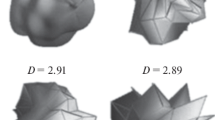Abstract
A theoretical approach to calculation of the parameters of fractal-like aggregates based on gas-kinetic results for homogeneous spheres is presented. The essence of the approach consists in the replacement of a real fractal aggregate by a sphere equivalent in mobility and approximation of the aggregate density and thermal conductivity by their effective values. The effectiveness of the approach has been confirmed in comparison with known experimental data. It has two important restrictions: a fractal aggregate should consist of a great number of primary particles (100 and more), and primary particles should be monodisperse. Violation of these conditions leads to considerable divergence between theoretical and experimental results.




Similar content being viewed by others
REFERENCES
S. A. Beresnev, M. S. Vasil’eva, V. I. Gryazin, and L. B. Kochneva, “Photophoresis of fractal-like soot aggregates: Microphysical model, comparison with experiment, and possible atmospheric manifestations,” Atmos. Oceanic Opt. 30 (6), 527–532 (2017).
S. A. Beresnev, V. G. Chernyak, and G. A. Fomyagin, “Motion of a spherical particle in a rarefied gas. Part 2. Drag and thermal polarization,” J. Fluid Mech. 219, 405–421 (1990).
S. Beresnev and V. Chernyak, “Thermophoresis of a spherical particle in a rarefied gas: numerical analysis based on the model kinetic equations,” Phys. Fluids 7 (7), 1743–1756 (1995).
C. M. Sorensen, “The mobility of fractal aggregates: A review,” Aerosol Sci. Technol. 45, 765–779 (2011).
M. D. Allen and O. G. Raabe, “Slip correction measurements of spherical solid aerosol particles in unimproved Millikan apparatus,” Aerosol Sci. Technol. 4, 269–286 (1985).
J. Yon, A. Bescond, and F.-X. Ouf, “A simple semi-empirical model for effective density measurements of fractal aggregates,” J. Aerosol Sci. 87, 28–37 (2015).
C.-W. Nan, R. Birringer, D. R. Clarke, and H. Gleiter, “Effective thermal conductivity of particulate composites with interfacial thermal resistance,” J. Appl. Phys. 81 (10), 6692–6699 (1997).
W. Evans, R. Prasher, J. Fish, P. Meakin, P. Phelan, and P. Keblinski, “Effect of aggregation and interfacial thermal resistance on thermal conductivity of nanocomposites and colloidal nanofluids,” Int. J. Heat Mass Transfer 51, 1431–1438 (2008).
S. Suzuki and R. Dobashi, “Effect of particle morphology on the thermophoretic behavior of soot particle,” in 20th Int. Colloq. Dyn. Expl. React. Syst. (ICDERS2005) (Montreal, 2005). p. 205-1–4.
S. Suzuki, K. Kawana, and R. Dobashi, “Effect of particle morphology on thermophoretic velocity of aggregated soot particles,” Int. J. Heat Mass Transfer 52, 4695–4700 (2009).
P. A. Baron and K. Willeke, Aerosol Measurement: Principles, Techniques, and Applications (Wiley-Interscience, New York, 2001), p. 1172.
V. V. Karasev, A. A. Onischuk, O. G. Glotov, A. M. Baklanov, E. A. Pilyugina, A. B. Kiskin, and V. E. Zarko, “Formation of titania nanoparticles via combustion of the pyrotechnic mixture,” in Proc. 35th Int. Ann. Conf. of ICT (Karlsruhe, 2004).
A. Messerer, R. Niessner, and U. Poschl, “Thermophoretic deposition of soot aerosol particles under experimental conditions relevant for modern diesel engine exhaust gas systems,” J. Aerosol Sci. 34, 1009–1021 (2003).
E. Brugiere, F. Gensdarmes, F. X. Ouf, J. Yon, and A. Coppalle, “Increase in thermophoretic velocity of carbon aggregates as a function of particle size,” J. Aerosol Sci. 76, 87–97 (2014).
L. A. A. Yahia, E. Gehin, and B. Sagot, “Application of the thermophoretic annular precipitator (trap) for the study of soot aggregates morphological influence on their thermophoretic behavior,” J. Aerosol Sci. 113, 40–51 (2017).
Funding
The work was performed within the State Assignment for Institutions of Higher Education, Russian Ministry of Education and Science (project no. 6064.2017/8.9) and with financial support of the Government of the Russian Federation (Contract no. 211, Agreement no. 02.A03.21.0006).
Author information
Authors and Affiliations
Corresponding author
Ethics declarations
The authors declare that they have no conflicts of interest.
Rights and permissions
About this article
Cite this article
Beresnev, S.A., Vasiljeva, M.S. & Kochneva, L.B. Motion of Fractal-Like Aggregates: Particle Settling Velocity and Thermophoresis. Atmos Ocean Opt 32, 528–533 (2019). https://doi.org/10.1134/S102485601905004X
Received:
Revised:
Accepted:
Published:
Issue Date:
DOI: https://doi.org/10.1134/S102485601905004X



